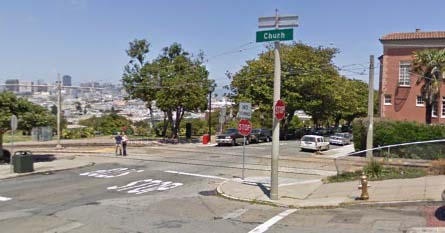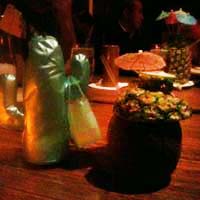
"The Little Giant's" 100 Year Watch
Each year on April 18 at 5:40 AM, The Upper Noe Valley Neighborhood Council and citizens arrive on a corner above San Francisco's Dolores Park with a flower wreath and spray cans of gold paint. They dress up a still-operating bronze fire hydrant with fresh gilding, and honor the firefighters who battled the 1906 San Francisco Fire which consumed much of the city after a devastating magnitude 7.9 earthquake. What makes this piece of plumbing so special?
"Though the water mains were broken and dry on April 18, 1906, yet from this Greenberg Hydrant on the following night there came a stream of water allowing the firemen to save the Mission District."
- Bronze plaque
Practically Biblical, no?
Tracking Down the Odd Landmark
Our discovery of this sturdy little icon began at the San Francisco Cable Car Museum at 1201 Mason Street, which has a series of interpretive panels that describe the San Francisco Earthquake and fire: The earthquake hits, entire blocks of houses collapse, the gas lines and water mains rupture, huge fires rage out of control in the mostly wood construction Victorian neighborhoods. There is no water in the pipes to fight the fire.
Though it must have seemed likely at the time, the whole world can not go up in flames; the fire has to stop somewhere. Where is the edge of mayhem, that frontier where the fire will finally stop? What will stop it? There is a mention of a single fire hydrant that continues to work as it should, and its location, a modest corner at Church St. and 20th St. near Noe Valley's popular Dolores Park. It seemed worthy of a visit.
 We wonder how obscure or how celebrated the hydrant is. Regardless of its celebrity, Chuck gets inflated, carries his best handbag, and is readied for a photo opportunity with history. We take the California Street cable car from the top of Nob Hill to downtown, then Light Rail to Dolores Park. The hydrant sits on the sidewalk, standing sentry over the city and the Bay as it did in 1906. Its gold paint gleams on a sunny day. There is a bronze plaque embedded in the sidewalk next to it, with its story.
We wonder how obscure or how celebrated the hydrant is. Regardless of its celebrity, Chuck gets inflated, carries his best handbag, and is readied for a photo opportunity with history. We take the California Street cable car from the top of Nob Hill to downtown, then Light Rail to Dolores Park. The hydrant sits on the sidewalk, standing sentry over the city and the Bay as it did in 1906. Its gold paint gleams on a sunny day. There is a bronze plaque embedded in the sidewalk next to it, with its story.
There is more evidence of the Little Giant's success as a working fire hydrant: Most of the houses on the western side of the street are Victorian, a more ornate style of architecture. On the eastern side of Dolores St. are Edwardian houses, a less-cluttered style of architecture, built in a more modern style after the Victorian houses were lost in the fire.
 So obscure a landmark is this locally made hydrant (probably poured at the foundry at 765 Folsom Street - did you know there are fire hydrant afficianados who can tell you these things?) that when we return home, we submit a picture of it to Google Earth where it is still the only picture of it in the Panoramio popups.
So obscure a landmark is this locally made hydrant (probably poured at the foundry at 765 Folsom Street - did you know there are fire hydrant afficianados who can tell you these things?) that when we return home, we submit a picture of it to Google Earth where it is still the only picture of it in the Panoramio popups.
Afterward, we all go to the Tonga Room for drinks, where Chuck becomes infatuated with an exotic coconut beauty in a parasol and pineapple hat.
This is another story for another day.
